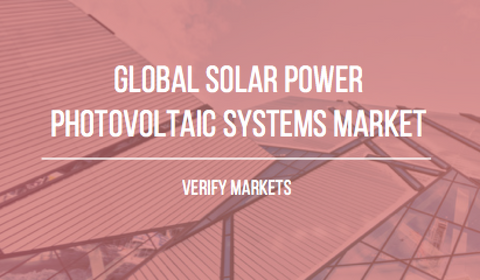2015 GLOBAL SOLAR POWER PHOTOVOLTAIC (PV) SYSTEMS MARKET
Pre-order the 2015 Global Solar Power Photovoltaic (PV) Systems Market and save 10% off the original price.
After booking, a Verify Markets analyst will contact you regarding market definition and segmentation. A collaborative Table of Contents is created and the final product is delivered after 45 days.
The global market for solar power photovoltaic (PV) systems is anticipated to grow at a rapid pace, owing to the rising energy demand and increasing shift towards renewable sources of energy, according to a Verify Markets analysis.
The use of fossil fuels and other non-renewable energy sources has given rise to environmental pollution. These environmental concerns have led the energy producing organizations and governmental authorities to shift their focus towards renewable sources of energy like wind, solar, and biogas, among others. Consider the case for solar energy’s potential. The surface of the earth receives 120,000 terawatts of solar radiation (sunlight) – 20,000 times more power than what is needed to supply the entire world.
The future manufacturing capacity expansion of solar power PV systems will take place in the Asia-Pacific region (other than that of China and Taiwan, due to the currently ongoing trade disputes). Furthermore, any such expansion is likely to be developed in proximity to emerging markets, which will make up a major share of future solar power PV development in the region.
By the end of 2014, cumulative photovoltaic capacity reached up to 178 gigawatts (GW), sufficient to supply 1 percent of global electricity demands. In 2015, solar contributed to 7.9 percent and 7.0 percent to the respective annual domestic consumption in Italy and Germany. By 2050, solar power is anticipated to become the world's largest source of electricity, with solar photovoltaic and concentrated solar power contributing 16 and 11 percent, respectively. This will require PV capacity to grow to 4,600 GW, of which more than half is forecasted to be deployed in China and India, according to Verify Markets analysis.
Solar power PV has an enormous energy potential and is usually seen as an environment friendly technology. Over the years, several countries have implemented specific policies and incentives to support solar power PV deployment. This has led to a rapid increase in the total installed capacity of PV from 1.4 GW in 2000 to around 70 GW at the end of 2011, with about 30 GW of capacity installed in the year 2011 alone. The associated industrial learning and market competition have resulted in very significant and rapid cost reductions for PV systems. Persistent cost reductions for PV systems are an essential requirement for accelerating the attainment of grid-parity of electricity generated using on-grid solar PV systems. In countries with good solar resources and high electricity tariffs, residential solar PV systems have already reached parity with electricity retail prices. In general, PV is now fully competitive with power generated from diesel-based on- and off -grid systems. Solar PV, as an alternative renewable electricity source, can be readily incorporated into existing grids up to a penetration level of about 20 percent, depending on the configuration of the existing electricity generation mix and demand profiles of the region.
Regions like the Middle East and Africa are encouraging the solar PV as one of the energy sources, due to the abundant resource of the solar power in the energy. The regions are potential and unexploited market in the solar power PV systems.
Companies like Amonix (U.S.), Soitec (France), Isofoton (U.S.), Semprius (U.S.), Solar Junction (U.S.), SunPower Corporations (U.S.), Suncor (U.S.), Solar Systems (Australia), Zytech Solar (Spain), Magpower (Portugal), and Ravano Green Powers (Italy) are some of the leading players in the solar power PV market, globally.

Every report purchase comes with 1 hour of Analyst Inquiry Time for a phone call with our analysts. This can be used for strategic advice, consultation, or addressing issues in your business and linking them to a solution. Analyst Inquiry Time must be used within 45 days of report purchase.


